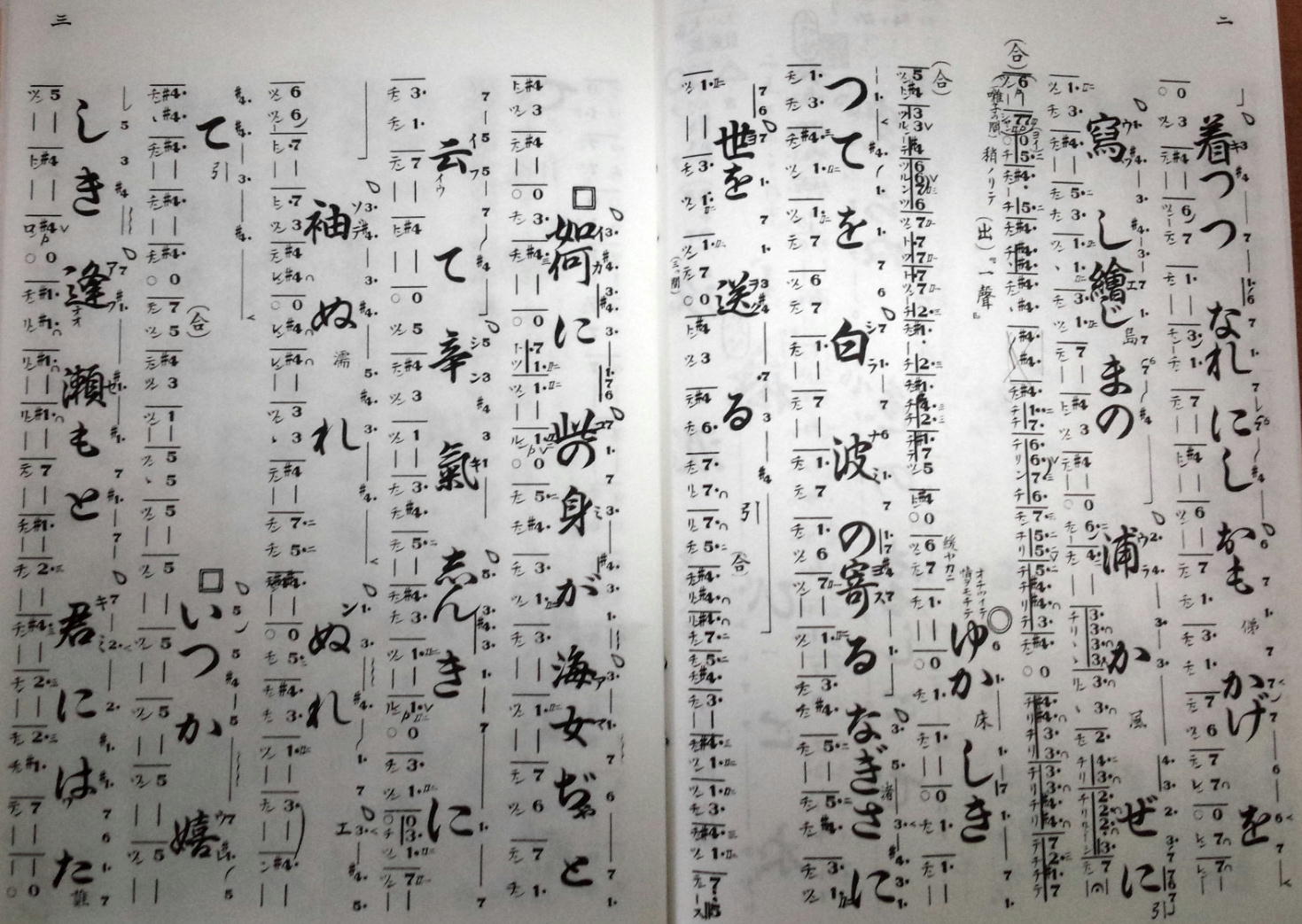Hi,
I saw some shamisen books with strange notation
Do someone know it? (or have links to help)
It looks to me like the pre-bunkafu/tabs style notation. It’s a bit hard to see the details, but searching up 伝統三味線文化譜 gives this result
Which is similar looking, at least at a glance.
http://isojiro.jp/wp-content/uploads/2006/10/echigojishi_glay.png
Thanks, I’ll look
If I found a response I may post it here
I think I found how to read it, even if it’s very unsimilar to the bunfa-fu;
The rhythm is the same
For notes its: .7 → 1 to 7 → 1. to 7. and 1… to 7…
1 seem is “C” (do)
I don’t know if it’s obligatory a do or not
also V is “su”, n is “ha” and the ligature is like “u” (in katakana)
Other is for the singers or onomatopées
This kind of notation is named for the Kenseikai, a nagauta group founded in 1902. (The group still exists) The right side of each line is a string of numbers without bar lines–this is the melody of the voice part. There are small katakana to indicate the pronunciation of kanji. The thick letters are the lyrics of the song. On the left side is the shamisen notation with bar lines.
The numbering system is a bit odd. There is no zero. Notation of the open string varies with the tuning. In honjoshi, the open strings (1,2,3) are ・7, 3, 7. The dot to the left of the first string seven indicates the lower octave. The 7 with no dot indicates the open third string in honjoshi. As the notes go up, a dot to the right of each number indicates a highter octave, and the highest possible octave has two dots. The tuning is indicated at the top of the first page, or at the top of a page where the tuning changes.
The open strings for ni-agari are ・7, #4, 7, and for sansagari they are ・7, 3, 6. Sukui notes are notated with v, and hajiki notes indicated with a half circle, like a fermata in western notation but without the little dot inside. Where fingering is not obvious, Roman numerals are used for index, middle and ring fingers (I, II, III).
It is a bit difficult to learn, compared to Bunkafu, but it is very popular among teachers, performers and students. More popular than Bunkafu? I don’t know, it’s hard to tell. One attractive feature is that the lyrics are from hand-written originals, the work of a calligrapher. Bunkafu uses, what do you call it, ‘font’ kanji.
Oooh! That’s neat. I hadn’t even considered the kanji might actually be properly lettered, but it’s quite obvious now.
I suspect bunkafu is really common in at least the min’yo community, and my kouta playing friends use it too. As an aside, their seasonal ensou always include booklets laden with calligraphy of the different songs’ lyrics.
so in this notation 1 is ALWAYS considered as C (do)?
It’s the only point I haven’t understood from the article I read
Oh, I forgot to mention that with the shamisen line, there is a line of solfege (kuchi shoga) that uses katakana don, ton ron, ten ren, chin, rin. Before shamisen notation was developed, shamisen players learned and memorized the music using this system, which tells you which string and which stroke type (hiki, sukui, hajiki). The pitch is indicated by the voice. Teachers still use this when indicating a passage verbally. Before I was familiar with this, I tried to indicate a melody using a neutral syllable like la. This is not understood at all without the kuchi shoga syllables.
@Jean-Christophe, yes, the numbers are constant for the pitches, so 1 is always C (assuming the tuning is based on bflat for open string one. The positions indicated by the numbers vary a bit based on the tuning in use.
Last questions about it:
0 is a rest? (like the black dot for bunka-fu notation?)
when there are 2 numbers (see 3rd column, 2nd measure), it’s a chord?
Thanks!
Yes, 0 is a rest, and two or three numbers indicate a chord. Also, I made a mistake in an earlier post. The fingering is indicated with Arabic numerals, and the string number is in Roman numerals (I had it the other way around). There is still more data in there. For example, the circle, square, and triangle used at the start of some voice passages indicate the lead singer, another solo singer, and ensemble. Vertical bars to the left of the shamisen numerals shorten each note, for example to double the number of notes per beat, or indicate syncopation, etc. There are also some phrases that indicate the desired expression/mood, or vaguely indicating tempo, like ‘hyoshi ni norite’ or ‘ride on the rhythm.’ The symbol shaped like a water drop is a breath mark; there are other phrasing marks for the singer. There is more, but I confess there are still details I don’t know. And a final important point: it is very difficult to play/sing this music effectively or correctly based only on the score. Input from a teacher is vital. (as is the case with western music as well.)

